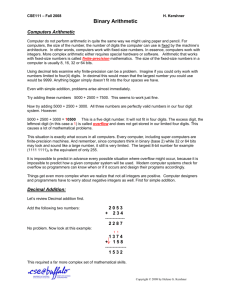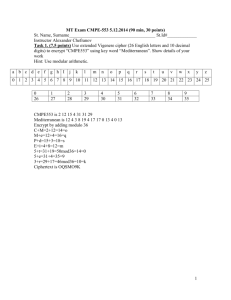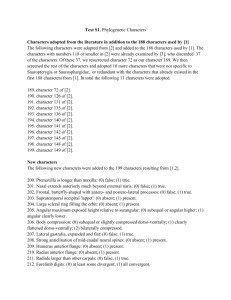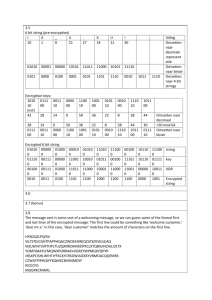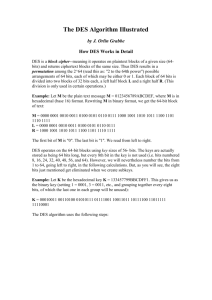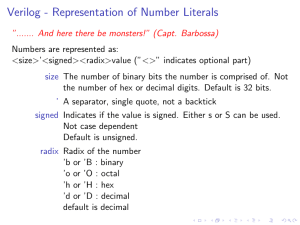Problems
advertisement
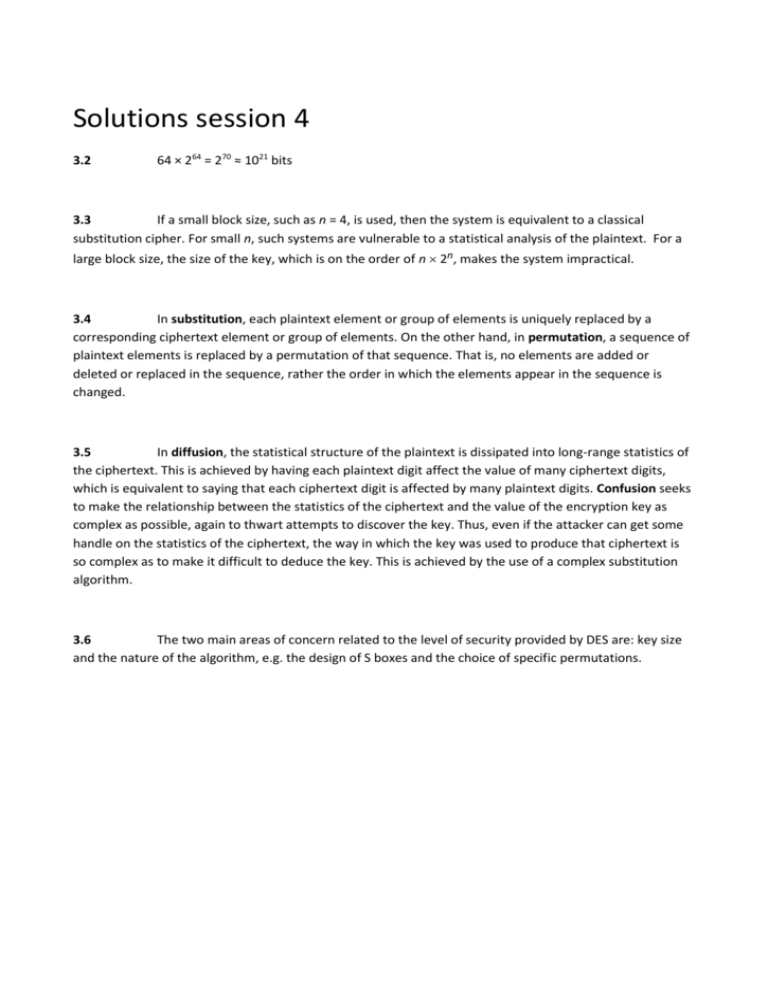
Solutions session 4 3.2 64 × 264 = 270 ≈ 1021 bits 3.3 If a small block size, such as n = 4, is used, then the system is equivalent to a classical substitution cipher. For small n, such systems are vulnerable to a statistical analysis of the plaintext. For a large block size, the size of the key, which is on the order of n 2n, makes the system impractical. 3.4 In substitution, each plaintext element or group of elements is uniquely replaced by a corresponding ciphertext element or group of elements. On the other hand, in permutation, a sequence of plaintext elements is replaced by a permutation of that sequence. That is, no elements are added or deleted or replaced in the sequence, rather the order in which the elements appear in the sequence is changed. 3.5 In diffusion, the statistical structure of the plaintext is dissipated into long-range statistics of the ciphertext. This is achieved by having each plaintext digit affect the value of many ciphertext digits, which is equivalent to saying that each ciphertext digit is affected by many plaintext digits. Confusion seeks to make the relationship between the statistics of the ciphertext and the value of the encryption key as complex as possible, again to thwart attempts to discover the key. Thus, even if the attacker can get some handle on the statistics of the ciphertext, the way in which the key was used to produce that ciphertext is so complex as to make it difficult to deduce the key. This is achieved by the use of a complex substitution algorithm. 3.6 The two main areas of concern related to the level of security provided by DES are: key size and the nature of the algorithm, e.g. the design of S boxes and the choice of specific permutations. Problems 3.9 3.10 0 1 2 3 4 5 6 7 8 9 10 11 12 13 14 15 0 1 2 3 4 5 6 7 8 9 10 11 12 13 14 15 Main key K = 111…111 (56 bits) Round keys K1 = K2 =…= K16 = 1111..111 (48 bits) Ciphertext C = 1111…111 (64 bits) Input to the first round of decryption = LD0RD0 = RE16LE16 = IP(C) = 1111...111 (64 bits) LD0 = RD0 = 1111...111 (32 bits) Output of the first round of decryption = LD1RD1 LD1 = RD0 = 1111…111 (32 bits) Thus, the bits no. 1 and 16 of the output are equal to ‘1’. RD1 = LD0 F(RD0, K16) We are looking for bits no. 1 and 16 of RD1 (33 and 48 of the entire output). Based on the analysis of the permutation P, bit 1 of F(RD0, K16) comes from the fourth output of the S-box S4, and bit 16 of F(RD0, K16) comes from the second output of the S-box S3. These bits are XOR-ed with 1’s from the corresponding positions of LD0. Inside of the function F, E(RD0) ≈ K16 = 0000…000 (48 bits), and thus inputs to all eight S-boxes are equal to “000000”. Output from the S-box S4 = “0111”, and thus the fourth output is equal to ‘1’, Output from the S-box S3 = “1010”, and thus the second output is equal to ‘0’. From here, after the XOR, the bit no. 33 of the first round output is equal to ‘0’, and the bit no. 48 is equal to ‘1’. 3.11 a. First, pass the 64-bit input through PC-1 (Table 3.4a) to produce a 56-bit result. Then perform a left circular shift separately on the two 28-bit halves. Finally, pass the 56-bit result through PC-2 (Table 3.4b) to produce the 48-bit K1.: in binary notation: 0000 1011 0000 0010 0110 0111 1001 1011 0100 1001 1010 0101 in hexadecimal notation: 0B02679B49A5 b. L0, R0 are derived by passing the 64-plaintext through IP (Table 3.2a): L0 = 1100 1100 0000 0000 1100 1100 1111 1111 R0 = 1111 0000 1010 1010 1111 0000 1010 1010 c. The E table (Table 3.2c) expands R0 to 48 bits: E(R0) = 01110 100001 010101 010101 011110 100001 010101 010101 d. A = 011100 010001 011100 110010 111000 010101 110011 110000 e. f. S100 (1110) = S10(14) = 0 (base 10) = 0000 (base 2) S201(1000) = S12(8) = 12 (base 10) = 1100 (base 2) S300 (1110) = S30(14) = 2 (base 10) = 0010 (base 2) 2 S10 4 (1001) = S4 (9) = 1 (base 10) = 0001 (base 2) 2 S10 5 (1100) = S5 (12) = 6 (base 10) = 0110 (base 2) S601(1010) = S16(10) = 13 (base 10) = 1101 (base 2) 3 S11 7 (1001) = S7 (9) = 5 (base 10) = 0101 (base 2) 2 S10 8 (1000) = S8 (8) = 0 (base 10) = 0000 (base 2) B = 0000 1100 0010 0001 0110 1101 0101 0000 g. Using Table 3.2d, P(B) = 1001 0010 0001 1100 0010 0000 1001 1100 h. R1 = 0101 1110 0001 1100 1110 1100 0110 0011 i. 3.12 L1 = R0. The ciphertext is the concatenation of L1 and R1. PC-1 is essentially the same as IP with every eighth bit eliminated. This would enable a similar type of implementation. Beyond that, there does not appear to be any particular cryptographic significance.


